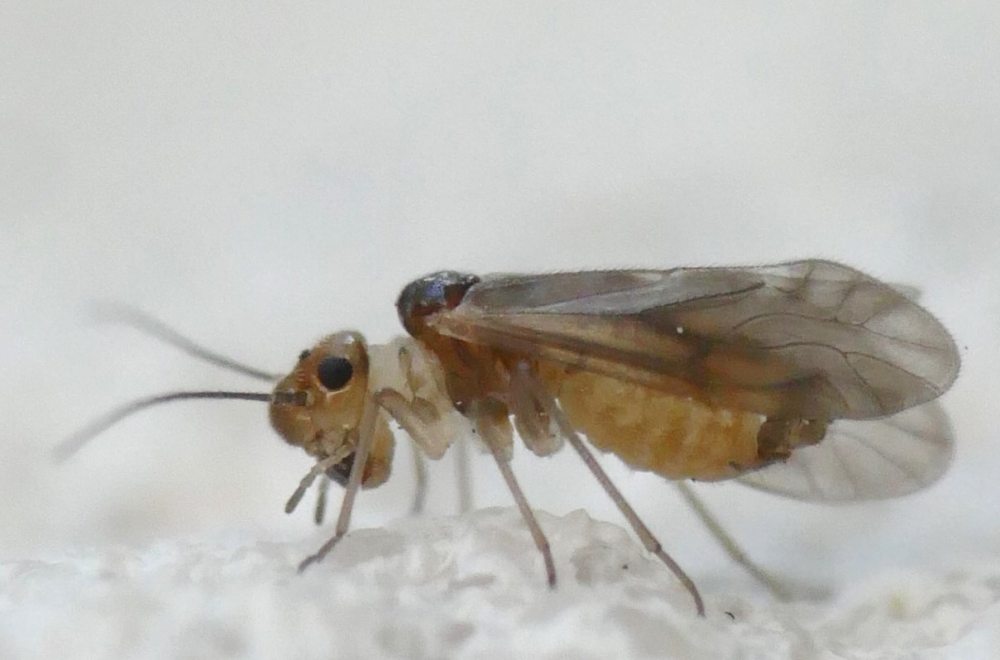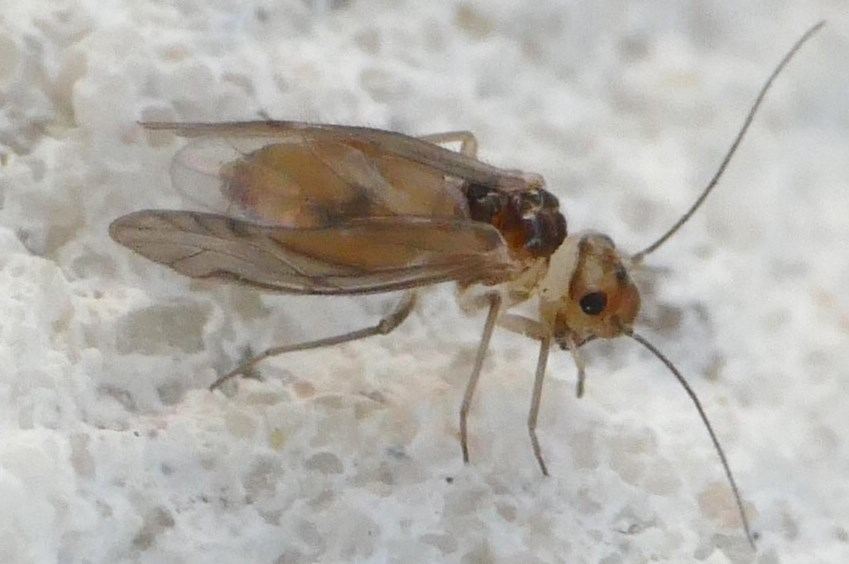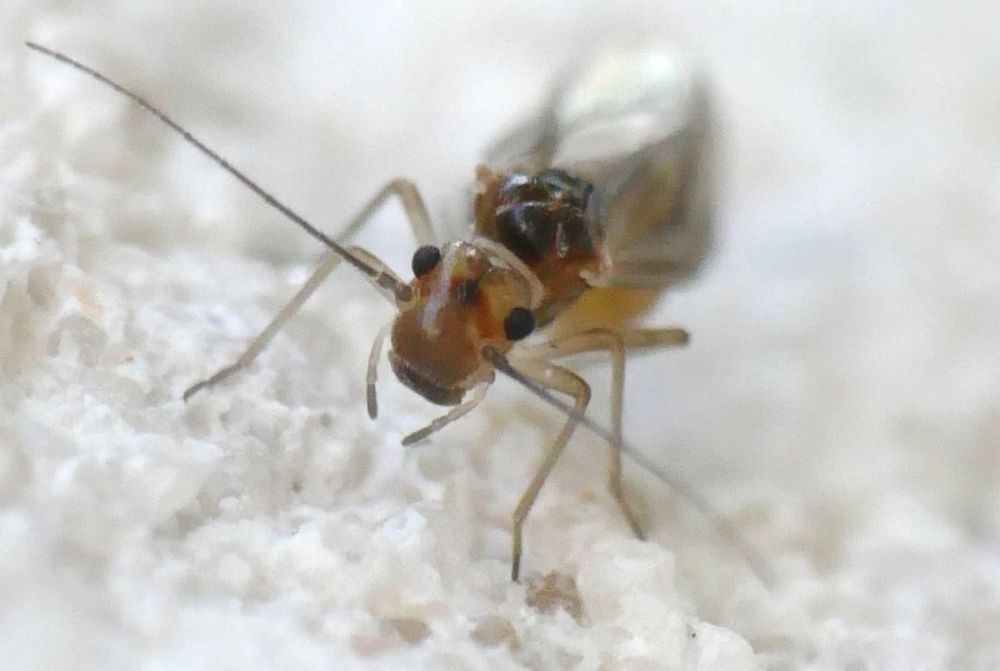Diptera.info :: Identification queries :: Other insects, spiders, etc.
|
Psocoptera, 2015-08-11, N. Germany => Valenzuela cf. corsicus
|
|
| Lennart Bendixen |
Posted on 07-12-2015 21:11
|
|
Member Location: Northern Germany Posts: 1171 Joined: 19.12.14 |
Hello, I have also some of the "normal ones" left, which I could not identify with my key (mostly because of the low photo quality). Who's got an idea? Thanks in advance, Lennart 2015-08-11, Northern Germany, S-H, Mohrkirch, house wall Lennart Bendixen attached the following image:  [97.84Kb] Edited by Lennart Bendixen on 11-12-2015 19:02 |
|
|
|
| Lennart Bendixen |
Posted on 07-12-2015 21:11
|
|
Member Location: Northern Germany Posts: 1171 Joined: 19.12.14 |
here's a second picture
Lennart Bendixen attached the following image:  [95Kb] |
|
|
|
| Johane |
Posted on 07-12-2015 22:18
|
|
Member Location: Gothenburg, Sweden Posts: 1969 Joined: 27.08.13 |
I come to Caeciliusidae with the Encyclopedia of the Swedish Flora and Fauna.
Johan Ennerfelt |
|
|
|
| Lennart Bendixen |
Posted on 07-12-2015 23:17
|
|
Member Location: Northern Germany Posts: 1171 Joined: 19.12.14 |
That seems plausible, many thanks! I think this should be Valenzuela sp. then. |
|
|
|
| Johane |
Posted on 09-12-2015 23:13
|
|
Member Location: Gothenburg, Sweden Posts: 1969 Joined: 27.08.13 |
In Sweden, the Caeciliusids that belong to other genera than Valenzuela look different from your specimen. But, I assume that you have many more species in Germany than we have in Sweden.
Johan Ennerfelt |
|
|
|
| Sundew |
Posted on 10-12-2015 00:42
|
|
Member Location: Berlin and Baden-Württemberg, Germany Posts: 3938 Joined: 28.07.07 |
The German Psocoptera species are listed here: http://www.ville-...s01ger.htm. The British barkfly key https://www.brc.a.../key/A.htm is very helpful as well as the gallery, but regrettably it does not cover all German species. As to your barkfly: in combination with the key in "Stresemann Exkursionsfauna" I arrive at Valenzuela burmeisteri but I don't guarantee for the correctness. The animals that I photographed and assigned to that species were much lighter coloured. So label it at most "Valenzuela cf. burmeisteri"... Edited by Sundew on 10-12-2015 00:45 |
|
|
|
| Lennart Bendixen |
Posted on 10-12-2015 10:59
|
|
Member Location: Northern Germany Posts: 1171 Joined: 19.12.14 |
Thank you both! I came to Valenzuela by comparing the german species of Caeciliusidae (Fauna Europaea) in the BRC gallery (if they were included) with my specimen ;-). Odd and uncertain way...but my own Exkursionsfauna has just arrived yesterday. So now I read it could be V. despaxi, too. Length was about 3 mm, but that doesn't really help in this case. |
|
|
|
| Johane |
Posted on 10-12-2015 12:05
|
|
Member Location: Gothenburg, Sweden Posts: 1969 Joined: 27.08.13 |
Checklist of Swedish Psocoptera http://artportale...16/3000179 V. corsicus is a synonym to V. rhenanus. This is the English version of my key, with microscopic and some other characters excluded. 1. Forewing less shining, without longitudinal band. -> not Caecilius fuscopterus 2. Thorax without or with indistinct lateral bands. -> not V. atricornis 3. Vein PCu of forewing setose -> 4 Vein PCu of forewing glabrous -> 5 The abovementioned is very difficult to see in the picture. 4. Head dark (brownish), with a few darker spots posteriorly (sometimes with a broad, dark, transverse band across ocelli). -> V. rhenanus Head paler (yellowish), without dark spots or band. -> V. burmeisteri 5. Pterostigma more or less distincly dilated distally. -> not Enderleinella obsoleta 6. Venation of forewing uniformly coloured, and uniformly distinct. -> not V. flavidus 7. Head pale (yellowish), with dark median stripe. -> V. despaxi Head predominately dark (reddish brown to blackish brown), sides paler. -> 8 8. Smaller, wing length 2.4-2.8 mm. Antenna distinctly shorter than forewing. -> V. piceus Larger, wing length 3.1-3.6 mm. Antenna distinctly longer than forewing. -> V. gynapterus I hope this is helpful. 
Edited by Johane on 10-12-2015 13:39 Johan Ennerfelt |
|
|
|
| Sundew |
Posted on 10-12-2015 12:52
|
|
Member Location: Berlin and Baden-Württemberg, Germany Posts: 3938 Joined: 28.07.07 |
Johane: great website - many thanks for posting the link! |
|
|
|
| Lennart Bendixen |
Posted on 10-12-2015 14:10
|
|
Member Location: Northern Germany Posts: 1171 Joined: 19.12.14 |
Good link, indeed. Thanks for posting your key - of course it helps, mentioning the head colour of V. despaxi! Great. Now I had to search for the original SD card and I was lucky, because I found a picture with a frontal view, which I - why ever - didn't copy to my computer. Seems to be rather V. despaxi then, do you agree? One should know the definition of "stripe", because this one is really thin and short ;-) Lennart Bendixen attached the following image:  [97.01Kb] |
|
|
|
| Johane |
Posted on 10-12-2015 15:31
|
|
Member Location: Gothenburg, Sweden Posts: 1969 Joined: 27.08.13 |
The picture in my book is taken from the side which makes it difficult to see what the median stripe looks like. Is it possible to see whether there are hairs on PCu or not? Johan Ennerfelt |
|
|
|
| Lennart Bendixen |
Posted on 10-12-2015 19:25
|
|
Member Location: Northern Germany Posts: 1171 Joined: 19.12.14 |
I can't see if there are hairs on pcu, no matter which picture I choose. The photos just aren't sharp enough. |
|
|
|
| Sundew |
Posted on 11-12-2015 01:50
|
|
Member Location: Berlin and Baden-Württemberg, Germany Posts: 3938 Joined: 28.07.07 |
Johane's key is good indeed. In combination with the British key and the Exkursionsfauna key we might be able to nail it. First I looked for species with a colourless line along wing vein r1 (seemingly visible in your second picture) and came to V. atricornis and V. burmeisteri https://www.brc.a...1-B-C2.htm). V. atricornis has distinctive dark lateral stripes on head and thorax and has to be omitted. V. burmeisteri looks lighter brown and has no dark head spots according to the Swedish key. The latter still mentions V. piceus that, according to the Exkursionsfauna, also has a colourless wing line (the British description, however, speaks of two light patches in the wing - https://www.brc.a...-C2-D9.htm). Head and legs seem to be much darker and without markings (http://www.fugleo...;ID=339957), so the species can be omitted, too. V. gynapterus, another species under concern, is mostly brachypterous and has a reddish-brown body colouration (http://www.fugleo...p;ID=82171), so improbable. V. despaxi is in the Exkursionsfauna not separated from V. burmeisteri except for its somewhat bigger size. The Swedish key, however, speaks of a pale head with dark median stripe. "Median" actually suggests a longitudinal stripe in the middle of the head, but the pictures in http://artportale...xon/234459 do not show such colouration. The animals are as light brown as V. burmeisteri. There is still V. rhenanus = corsicus left. In the net, there are pictures of darker and lighter ones (e.g. http://www.biodiv...40843.html), the wings are said to be patchy with darker and lighter marks, and the Swedish key says, "sometimes with a broad, dark, transverse band across ocelli". Your last "portrait" shows just such a darker transverse band that includes the ocelli. I find that character convincing and would label the pictures "Valenzuela cf. corsicus" - that can't be too wrong! Edited by Sundew on 11-12-2015 01:50 |
|
|
|
| Paul Beuk |
Posted on 11-12-2015 10:53
|
|
Super Administrator Location: Netherlands Posts: 19403 Joined: 11.05.04 |
For keys one can also consult Lienhard, Ch., 1998. Psocoptères euro-méditerranéens. - Faune de France 83: 1-517: http://faunedefra...ptère.pdf. You may have to brush up your French... 
Paul - - - - Paul Beuk on https://diptera.info |
| Sundew |
Posted on 11-12-2015 16:49
|
|
Member Location: Berlin and Baden-Württemberg, Germany Posts: 3938 Joined: 28.07.07 |
Gigantesque! Merci beaucoup, Paul! Charles Lienhard is definitely the greatest Psocopterist. However, in his treatment of 1998 he included Valenzuela in Caecilius, which has not been adopted in the Fauna Europaea. He also wrote the German Psocoptera key to our Exkursionsfauna of 2011 and returned to Valenzuela therein. Anyhow, he writes "pas de bande brun-rouge entre le tubercule ocellaire et les bases des antennes" => rhenanus, so I stay with Caecilius (Valenzuela) rhenanus. BTW, this name is not mentioned in the Fauna Europaea, not even as a synonym for V. corsicus. Edited by Sundew on 11-12-2015 16:51 |
|
|
|
| Lennart Bendixen |
Posted on 11-12-2015 19:01
|
|
Member Location: Northern Germany Posts: 1171 Joined: 19.12.14 |
What's happened here?!  I'm overwhelmed. I'm overwhelmed.Thanks so much for spending so much time on my request! So the transverse bande brun-rouge seems to be a unique characteristic, at least in this genus. That's good to know. I see, I'd need to spend much more time on Psocoptera, but every order is so interesting, I just don't know, where to start....  |
|
|
|
| Paul Beuk |
Posted on 14-12-2015 08:53
|
|
Super Administrator Location: Netherlands Posts: 19403 Joined: 11.05.04 |
It is listed as synonym of corsicus: http://www.faunae...?id=169414. I noticed that the new version of Fauna Europaea has synonyms missing from the listings and I still revert back to the old version. Edited by Paul Beuk on 14-12-2015 08:54 Paul - - - - Paul Beuk on https://diptera.info |
| Jump to Forum: |













